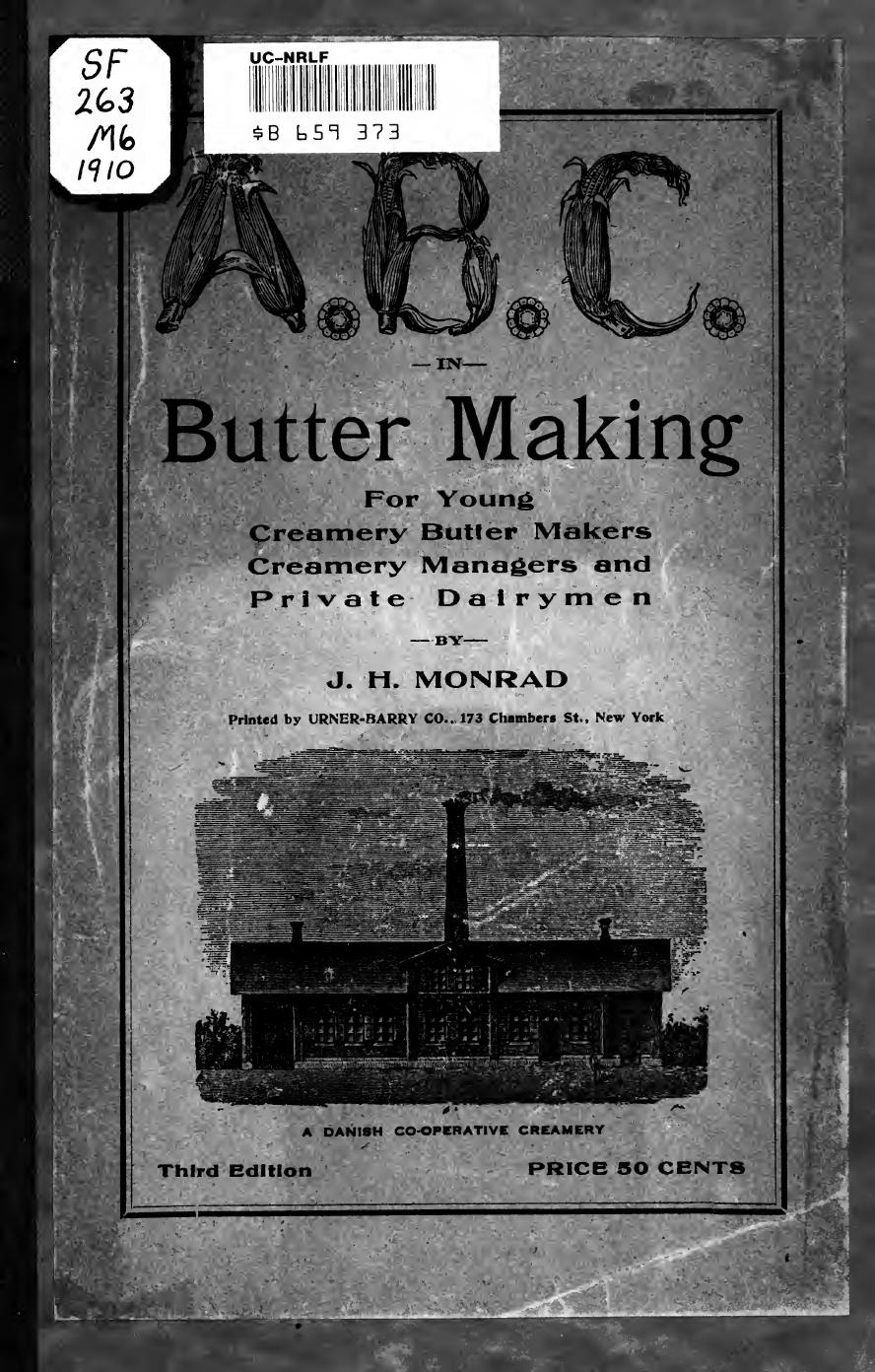A.B.C. in butter making : for young creamery butter makers, creamery managers and private dairymen by Monrad John Henry 1848-1915

Author:Monrad, John Henry, 1848-1915
Language: eng
Format: epub, pdf
Tags: Butter
Publisher: New York : Printed by Urner-Barry Co.
Published: 1910-03-25T05:00:00+00:00
will soon smell musty and that is the great danger with our large creamery churns compared with the small Danish ones.
Never fill the churn too full, as a rule it is safest to put in less than the manufacturers tell you. End over barrel and box churns should not be filled more than half, but it really depends on the ''fall" that is left, that is, if a churn 24 inches deep may be half filled, one only 18 inches should not be filled so full, as that would give the cream a 9-inch instead of a 12-inch drop.
It is always safest to strain the cream into the churn and the coloring should be calculated according to the butter expected. It is easy to keep track of how much milk each vat represents anl use yesterday's yield for an estimate.
Until lately two kinds of butter color have been on the market, the purely vegetable (Annatto) as represented by Chr. Hansen's Danish and Thatcher's, and the aniline or coal tar colors among which Wells & Richardson Co.'s and the Alderney were best known. The latter were free from sediment, strong and cheap, but since the enactment of the Pure Food Law the coal tar colors have been abandoned and Wells & Richardson Co. are now producing a vegetable color. In the minute quantities in which butter color enters into the butter the coal tar colors-could hardly be considered dangerous, but since the vegetable colors answer the purpose fully it is better to be on the safe side..
The quality of the oil used as well as the shade and brightness imparted to the butter must be considered in selecting the color.
HAND CHURNING.
Start the churn, and do not forget to ventilate it once or twice during the first minutes and then make sure of the tempera--ture.
After this, strike the right gait (given by the manufacturer), or learned by experience, keep it going steadily^—do not get curious and stop to look at it until the regular time has elapsed or the change in the sound warns you that the cream is "broken." If you are musical a song may help you to keep time. If it should not come on time, stop and take the temperature, and if that is wrong correct it by adding hot or cold water. It is also a good plan to take the temperature and regulate if necessary when it is "broken," because if it is too high the butter is apt to retain too much water (16 per cent or more) and Uncle Sam may prosecute 3^ou. Then churn again a little slow-er, but with a steady motion till the granules are of the right size. Some makers prefer them 1-16, others 1-8 of an inch in diameter. I think the latter a little too large and prefer the size between the two.
Sometimes, if the butter does not come, the cream may foam and nearly fill the churn. This may be caused by (i), the cream being too
Download
A.B.C. in butter making : for young creamery butter makers, creamery managers and private dairymen by Monrad John Henry 1848-1915.pdf
This site does not store any files on its server. We only index and link to content provided by other sites. Please contact the content providers to delete copyright contents if any and email us, we'll remove relevant links or contents immediately.
The Vikings: Conquering England, France, and Ireland by Wernick Robert(79172)
Ali Pasha, Lion of Ioannina by Eugenia Russell & Eugenia Russell(39927)
The Vikings: Discoverers of a New World by Wernick Robert(36828)
The Conquerors (The Winning of America Series Book 3) by Eckert Allan W(36701)
Cecilia; Or, Memoirs of an Heiress — Volume 1 by Fanny Burney(32074)
Cecilia; Or, Memoirs of an Heiress — Volume 3 by Fanny Burney(31469)
Cecilia; Or, Memoirs of an Heiress — Volume 2 by Fanny Burney(31419)
Empire of the Sikhs by Patwant Singh(22774)
Hans Sturm: A Soldier's Odyssey on the Eastern Front by Gordon Williamson(18332)
The Secret History by Donna Tartt(18210)
Cat's cradle by Kurt Vonnegut(14776)
Sapiens: A Brief History of Humankind by Yuval Noah Harari(13995)
Pimp by Iceberg Slim(13797)
Talking to Strangers by Malcolm Gladwell(12888)
Norse Mythology by Gaiman Neil(12858)
Leonardo da Vinci by Walter Isaacson(12811)
Underground: A Human History of the Worlds Beneath Our Feet by Will Hunt(11846)
4 3 2 1: A Novel by Paul Auster(11808)
The Radium Girls by Kate Moore(11633)
